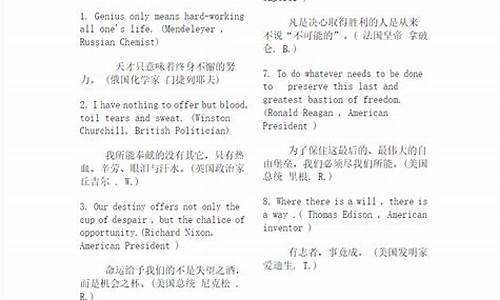高中英语句子基本结构_高中英语句子结构分析
1.高中英语句子成分与语法,主语谓语什么的和名词及物不及物动词等分析.谢谢啦
2.高中英语句子分析
3.英语的句子成分都是啥啊?高中了,不是很明白。希望大家帮帮忙,讲清楚些。谢了
4.英语句子的构成 像 宾语谓语的 不及物动词和及物动词。。 的用法
5.高中英语句子成分分析?

1.主语our school 谓语is 状语not far from my home
2.形式主语it真正的主语不定式短语
3.主语all of us谓语considered宾语him宾语补足语honest
4.buy后接双宾语结构me是间宾a pair of sports shoes是直宾a pair of sports做定语修饰shoes
5.第五个是个复合句。主语he谓语made宾语it宾补clear.that从句做made的宾语。其中he做主语would lee做谓语the city做宾语
6.复合句,前一个是主谓状结构后一个是when引导的时间状从
7.主谓双宾结构me是间宾an interesting story是直宾last nignt是状语
8.主谓双宾结构
9.考到了一个句型think highly of sb 主谓宾结构
10.主谓宾状结构
11.主谓宾宾补结构
12.主谓宾宾补结构
13.祈使句
14.主谓状结构whatever引导的宾语从句又做了do的宾语
15.主谓宾状结构
16.get sth.done句型 主谓宾状结构
17.主谓状结构,从in Japan开始都做了made的状语,而且还是用了比较
18.there be 句型 that从句中it 作了形式主语,不定式是真正的主语。
19.状语从句而且用了倒装,we must~~是主谓宾状结构
20.主谓宾宾补结构
高中英语句子成分与语法,主语谓语什么的和名词及物不及物动词等分析.谢谢啦
结构式这样的:
this
做主语,肯定是上文提到的某件事。
谓语动词是
will
result
in,
会导致。
宾语是a
smaller
number
of
fish,
核心是number,数量,究竟是什么的数量,
鱼的数量。
left,
是过去分词做后缉粻光救叱嚼癸楔含盲置定语,
表示剩下的,
什么样的鱼,
剩下的鱼。
for
us
to
eat,
是动词不定式表目的。
剩下的鱼干什么,供我们
吃。
in
the
future,
时间状语,在将来。
所以整句话翻译就是:
这会导致将来可供我们食用的鱼的数量越来越少。
高中英语句子分析
动词根据其后是否带有宾语,可分为两类,分别是:及物动词(Transitive Verb)、不及物动词(Intransitive Verb),缩写形式分别为vt. 和vi.。
英语动词是句子的核心。它既决定着句子意思的表达同时又决定着句子的语法结构。首先,要分清及物不及物动词。
动词及物与不及物通常有以下几种情况:
a.主要用作及物动词。及物动词后面必须跟宾语。可以用于:"主+谓+宾";"主+谓+双宾";"主+谓+宾+宾补"结构。如:
He reached Paris the day before yesterday.
They asked me to go fishing with them.
类似的还有:buy, catch, invent, found, like, observe, offer, prevent, promise, raise, find, forget, receive, regard, see, say, seat, supply, select, suppose, show, make, take, tell....
b.主要用作不及物的动词。不及物动词后面不跟宾语。只能用与:"主+谓"结构。
This is the room where I once lived.
类似的还有:agree, go, work, listen, look, come, die, belong, fall, exist, rise, arrive, sit, sail, hurry, fail, succeed....
c.既可以用作及物又可以用作不及物的动词,其意义不变。如begin 都是作"开始"讲。everybody , our game begins. let us begin our game. 类似的还有:start, answer, sing, close, consider, insist, read, learn, prepare, pay, hurt, improve....
d.既可以用作及物又可以用作不及物的动词,其意义完全不同。
这类动词作不及物动词是一个意义;而作及物动词时却是另一个意义。如lift作不及物动词时是指烟雾的"消散"。we saw the mountain when the clouds lifted. 作及物动词时是"升高;举起"。
He lifted his glass and drank.
类似的还有:beat vi.跳动 vt. 敲、打; grow vi.生长 vt. 种植
play vi.玩耍 vt. 打(牌、球),演奏 smell vi.发出(气味) vt. 嗅
ring vi.(电话、铃)响vt.打电话 speak vi.讲话 vt. 说(语言)
hang vi. 悬挂 vt. 绞死 operate vi.动手术 vt. 操作
英语的句子成分都是啥啊?高中了,不是很明白。希望大家帮帮忙,讲清楚些。谢了
主句是Teachers……gardeners,翻译为教师总是被比喻为园丁;其中,teachers为主语,谓语部分是be
compared
to
“被比喻为”;always,副词修饰are,表程度;gardeners为宾语
while引导一个省略从句,student为主语,因谓语与主句相同,避免重复,就省略了is
compared
to
young
trees
and
flowers
做宾语。翻译为
而学生被喻为幼小的树苗和花朵
英语句子的构成 像 宾语谓语的 不及物动词和及物动词。。 的用法
高中要求掌握的句子成分主要包括主语、谓语、宾语、定语、状语、补语。
这些成分的判断基本和汉语是一致的。
主语是执行句子的行为或动作的主体,如“我写字”中的“我”,就是主语,它做出“写”这个动作。“写”则是谓语,而“字”是接受谓语“写”这个动作的对象,它因此被称为宾语,有的语法书也称它为“客体”或“受体”。主语可以这些列词类或形式来担任:名词,代词,名词化了的动词,形容词,分词,副词或数词等,动词不定式或不定式短语,从句等。
定语是用来修饰、限定、说明名词或代词的品质与特征的。 主要有形容词此外还有名词、代词、数词、介词短语、动词不定式(短语)、分词、定语从句或相当于形容词的词、短语或句子都可以作定语。 汉语中常用‘……的’表示。定语和中心语之间是修饰和被修饰、限制和被限制的关系。在汉语中,中心语与定语二者之间有的需要用结构助词“的”,有的不需要,有的可要可不要。 “的”是定语的标志。
The little boy needs a blue pen.(little修饰名词boy,就是定语;blue修饰名词pen,也是定语.)/小男孩需要一支蓝色的钢笔。
状语:状语说明地点、时间、原因、目的、结果、条件、方向、程度、方式和伴随状况等。 状语一般由副词、介词短语、分词和分词短语、不定式或相当于副词的词或短语来担当。其位置一般放在句末,但也可放在句首或句中。 副词是一种用来修饰动词,形容词,副词或全句的词,说明时间,地点,程度,方式等概念。
1.副词一般在句子中做状语. He speaks English very well. 他英语说得非常好.中的very是程度状语,用来修饰well。very well是修饰speak的程度状语。 He is playing under the tree.他在树下玩儿.中的under the tree是地点状语.
2. 不定式在句子中可以作目的状语。
I come specially to see you.我专门来看你.
3.介词短语 Ten years ago, She began to live in Dalian. The boy was praised for his brery.
4.从句作状语 When she was 12 years old, she began to live in Dalian. If I am not busy tomorrow, I will play football with you.
5.分词作状语 Hing had a quarrel with his wife, he left home in a bad temper。 Inhibited in one direction, it now seems that the Mississippi is about to take another.
英语补语的作用对象是主语和宾语,具有鲜明的定语性描写或限制性功能,在句法上是不可或缺的。补语是起补充说明作用的成份。最常见的是宾语补足语。名词、动名词、形容词、副词、不定式、现在分词、过去分词都可以在句子中作宾补。
主语的补语
它用在系动词后,是句子的一个基本成分。常用主-系-表结构。 1.I saw her with them, at least, I thought it was her. 我看到她和他们在一起,至少,至少我认为是她。(her做宾语,with做介词宾语,them做主语补语)
2.. -- Who broke the vase? --谁打碎了花瓶? -- Me. --我。 (me做主语补语= It's me.)
3.John hoped the passenger would be Mary and indeed it was she. (she做主语补语) 约翰希望那位乘客是玛丽,还真是她。
宾语的补语
不定式(to do)作补语 Father will not allow us to play on the street. 父亲不让我们在街上玩耍。
We believe him to be guilty. 我们相信他是有罪的。
We made him copy the sentence.
He is made to copy the sentence.
I felt my hands tremble.
名词作补语 At the meeting we elected him monitor.
I think your brother a clever boy.
形容词作补语 What you said made Xiao Wang angry.
I found the classroom empty
副词作补语 Please call the students back at once.
He was seen to take his cap off.
现在分词作补语 We hear him singing in the hall.
I found him lying in bed, sleeping.
过去分词作补语 He saw his face reflected in the water.
I heard it spoken of in the next room.
VS天才翻译家 希望能帮到您。
高中英语句子成分分析?
英语句子结构有五种(主谓,主谓宾,主系表,主谓宾宾和主谓宾宾补)
主谓:I study.
主谓宾:I like banana.
主系表:I am a student.
主谓双宾:I give a pencil to him.
主谓复合宾语:I make him hy.
1. 主语+谓语(不及物动词) [S + V]
如:The children are playing hily.
孩子们正在高兴地玩。
2. 主语+谓语(及物动词)+宾语 [S+V+O]
如:The Greens enjoy living in China.
格林一家喜欢住在中国。
3. 主语+谓语+表语 [S+V+P]
该句型谓语动词为连系动词。常见的系动词有:be(是); get(变得), become(成为), turn(变得), look(看起来), feel(感到), smell(闻起来), taste(尝起来), sound(听起来), seem(似乎) 等。如:
① He became a famous doctor.
他成为了一名著名的医生。
② The le pie tastes really delicious.
苹果派吃起来真是好吃。
4. 主语+谓语+间接宾语+直接宾语 [S+V+InO+DO]
这种句型中的及物动词后跟双宾语,既指人的间接宾语和指物的直接宾语。也可以把间接宾语放在直接宾语之后,但要加介词for或to。如:
① My aunt bought me a computer. = My aunt bought a computer for me. 我阿姨买给我一台电脑。
② I passed him the salt. = I passed the salt to him.
我把盐递给他。
5. 主语+谓语+宾语+宾语补足语 [S+V+O+OC]
如:We must keep our school clean.
我们必须保持我们的学校清洁。
1. Subject (主语) + Verb (谓语)
这种句型中的动词大多是不及物动词,这些动词常见的有:ear, apologize,arrive, come, die, disear, exist, fall, hen, rise,等等。如:
The students work very hard.学生们学习很努力。
She apologized to me again. 她再次向我道歉。
The accident hened yesterday evening.事故是昨天晚上发生的。
2. Subject (主语) + Link. V(系动词) + Predicate(表语)
这种句型中的系动词一般可分为下列两类:
(1)表示状态的连系动词。这些词有:be, look, seem, ear, smell, taste, sound, keep, remain, 等等。如:
Several players lay flat on the playground.几个队员平躺在操场上。
We should remain modest and prudent any time.我们在任何时候都应该保持谦虚谨慎。
This kind of food tastes terrible.这种食物吃起来很糟糕。
The picture looks more beautiful at a certain distance.这幅画在一定的距离看更漂亮一些。
(2)表示转变或结果的系动词。这些词有:become, get, grow, turn, go, come, prove,等等。如:
Spring comes. It is getting warmer and warmer.春天到了,天气变得越来越暖和。
Don't he the food. It has gone bad.不要吃那种食物,已经变质了。
The facts prove true.事实证明是正确的。
3. Subject(主语) + Verb (谓语) + Object (宾语)
这种句型中的动词应为及物动词或者可以后接宾语的动词短语。同时,句子中有时含有与宾语有关的状语。作宾语的成分常是:名词、代词、动词不定式、动名词或从句。如:
You can put the books in your bag.你可以把书放在书包里。
Farmers in our area grow lots of vegetables.我们这里的农民种很多种蔬菜。
She lost the chance to make her earance on the stage.她失去了在舞台上露面的机会。
I prefer to make web pages.我更喜欢做网页。
4. Subject(主语)+Verb(谓语)+ Indirect object(间接宾语)+Direct object (直接宾语)
这种句型中作间接宾语的常常指“人”,直接宾语常常指“物”。如:
Yesterday her father bought her a bicycle as a birthday present.昨天她父亲给她买了一辆自行车作为生日礼物。
The old man is telling the children stories in the Long March.老人正在给孩子们讲长征中的故事。
这种句型还可转换为其他两种句型:1)动词 + 宾语 + for sb.; 2)动词 + 宾语+to sb.。如:
Please show me your picture. /Please show your picture to me.
请把你的画给我看一下。
I'll offer you a good chance as long as you don’t lose heart.
—I'll offer a good chance for you as long as you don't lose heart.
只要你不失去信心,我会给你提供机会的。
5. Subject(主语)+Verb (动词)+Object (宾语)+Complement(补语)
这种句型中的宾语+ 补语可统称为“复合宾语”。担任补语的常常是名词、形容词、副词、介词短语、分词、动词不定式等。如:
Keep the children quiet, please. 请让孩子们安静下来。
He painted the wall white. 他把墙漆成白色。
We found him an honest person.我们发现他是一个诚实的人。
His mother told him not to play on the street.他母亲告诉他不要在街上玩。
注意:动词he, make, let, see, hear, notice, feel, observe, watch等后面所接的动词不定式作宾补时,不带to。如:
The boss made him do the work all day.老板让他整天做那项工作。
1. 主语+ 不及物动词
例:It is raining heily. /My tooth aches.
2. 主语 + 及物动词 + 宾语
例:They enjoy the play. /I met John in the street yesterday.
3. 主语 + 系动词 + 表语
例:He is out. /Jenny is fine. /It looks like rain, soon.
4 主语 + 及物动词 + 双宾语
例:He bought her a watch. /The sun gives us light.
注意:双宾语一个指人(即间接宾语),另一个指物(即直接宾语)。一般间接宾语位于直接宾语的前面,有时它们也可交换位置,这是需要在间接宾语的前面加上介词to 或for 。
常见的双宾语结构:bring sb. sth (bring sth to sb). give sb. sth (give sth to sb.)
hand sb. sth (hand sth to sb.) lee sb. sth (lee sth.to sb)
lend sb. sth (lend sth to sb) pass sb sth (pass sth to sb)
return sb. sth (return sth to sb) send sb sth (send sth to sb)
show sb sth (show sth. to sb.) tell sb sth (tell sth to sb )
write sb sth (write sth to sb ) buy sb sth (buy sth for sb )
do sb sth (do sth for sb ) get sb sth (get sth for sb )
make sb. sth (make sth for sb) pay sb. sth (pay sth for sb)
sing sb sth (sing sth for sb )
5. 主语 + 及物动词 + 宾语 + 补足语
例:She found him a very clever student. / I make it a rule to get up early in the morning.
(S+V+P)
The bike is new. /The map is on the wall.
第二种 主语+不及物动词 (S+V)
He swims.
第三种 主语+及物动词+宾语 (S+V+O)
Children often sing this song.
第四种 主语+及物动词+间接宾语+直接宾语 (S+V+IO+DO)
She showed her friends all her pictures.
这句话意思是:时钟刚刚敲响十二点,残酷的入侵者涌入了这个国家的边界,并占领了这座城市,他们屠戮了成千上万的无辜百姓,整个战区陷入了一片火海。
As soon as是一个时间状语,一……就……
由两个并列句型一起构成主句,第一个句子的主语是the intruders
第一个句子的谓语动词是invaded and conquered
killing是现在分词,表示伴随invaded and conquered发生的动作
第二个句子的主语是the war zone
第二个句子的谓语动词是was
声明:本站所有文章资源内容,如无特殊说明或标注,均为采集网络资源。如若本站内容侵犯了原著者的合法权益,可联系本站删除。












